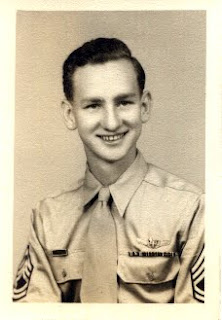
I recently wrote to the National Personnel Records Center to see if they had records of my father's military service. The request can be made on-line for next of kin through NARA's web site. I wasn't surprised to find that the records were "lost in the July 1973 fire that destroyed millions of records here." NARA followed up with a request that I provide information to help them reconstruct their data base.
Luckily, I have a significant file of documents, including original signed flight reports and his discharge from both World War II and the Korean War, newspaper clippings, and his uniform.
Joseph C. Szymanowicz enlisted in February of 1943, prior to his graduation from Northampton, MA High School and prior to his 18th birthday. He began his service at Fort Devins 30 August 1943 and trained in Miami Beach with the Army Air Corps. He was sent to radio school in Sioux Falls SD for 20 weeks and then to Yuma AZ for gunnery training, at which time he was promoted to Corporal. After 20 days leave at home in Northampton in September of 1944, he was assigned to a B-24 Liberator at Westover. The crew spent the rest of the year flying out of Chatham Field in Savannah GA, before shipping out of Norfolk VA, arriving in Naples, Italy 21 February 1945.
They flew bombing missions over Austria. Few fliers survived more than the 22 that they completed, according to Ken Burns' PBS series "The War." They were disabled over Yugoslavia and forced to land in a field. When they returned to their base in another aircraft, the alarm was raised. Dad said his buddies had already raided his hoard of chocolate bars in their absence.
His Separation Qualification Record states that he "Sent and received radio messages using army equipment, code and procedure on air to ground basis using international morse code. Sent 27, received 25 words per minute. Made minor repair on military radio equipment. Did some Radar work. Manned right waist machine gun in 22 missions over Mediterranean Theatre with 15th AAF." He was honorably Discharged at Westover Field on 5 November 1945.
The men from his bomber got together periodically over the years and kept in touch at Christmas. The bond that they formed over those months in Italy lasted for the rest of their lives. Dad died 26 April 2000 at the age of 74. My son carries his screaming eagle patch with him in Afghanistan today, where he is also in the 101st Airborne. Miss you, Dad!
